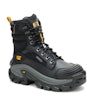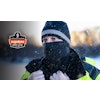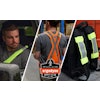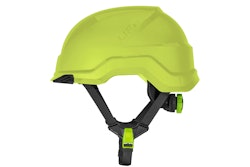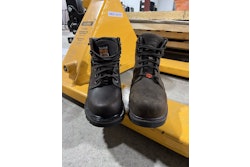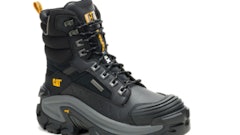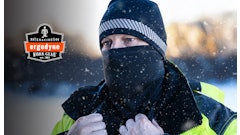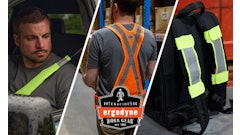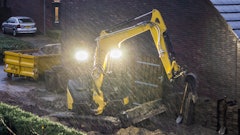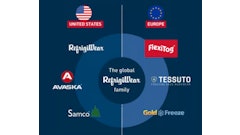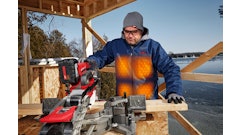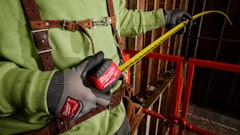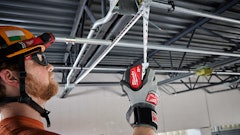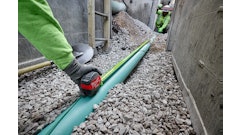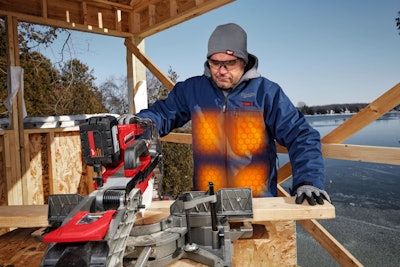
As winter approaches and temperatures plummet, staying warm on the job becomes more than just a matter of comfort, it’s essential for safety and productivity. From construction sites to outdoor maintenance, professional tradesmen and tradeswomen face the harsh realities of working in freezing conditions daily. Cold environments pose significant risks, including reduced dexterity and slower reaction times. In these jobsite environments, the ability to stay warm is crucial not only for comfort but also for maintaining performance and benefitting safety.
Over the years, heated workwear has evolved from basic thermal clothing to battery-powered heated jackets and vests that deliver consistent warmth. This evolution reflects the growing recognition of the importance of thermal protection on the jobsite. Innovations in heated workwear technology have made it possible to keep users warm without sacrificing mobility or comfort, leading to significant improvements in jobsite performance and overall safety. Companies have been at the forefront of these advancements, continuously pushing the boundaries to develop more effective and user-friendly solutions.
The Evolution of Heated Workwear
In the early 2000s, the concept of heated workwear began to take shape. Initially, thermal workwear consisted of thick, insulated clothing designed to trap body heat. While effective to a degree, these early garments were often bulky and heavy, restricting movement and limiting a user’s efficiency on the jobsite. As the need for better solutions grew, the professional industry started to explore new materials and technologies to enhance thermal protection.
The real breakthrough came with the introduction of battery-powered heated gear. This innovation revolutionized the market, offering workers greater mobility and flexibility. No longer tethered to external power sources, professionals could now move freely on the jobsite while staying warm. Early battery-powered heated jackets and vests, though a significant improvement, still faced challenges in terms of heat distribution and battery life.
In 2010, Milwaukee Tool made a bold entry into the heated gear market with the launch of their first heated jacket. Utilizing the same M12™ REDLITHIUM™ battery packs that deliver high performance in their power tools, these jackets were designed to tackle common frustrations such as inconsistent warmth and lack of durability, quickly gaining popularity among professional tradespeople. The company's relentless commitment to disruptive innovation and quality led to the development of the TOUGHSHELL™ Heated Jacket, delivering reliable heat and enhanced durability suited for frigid jobsite conditions.
Advancements in Heated Workwear Technology
Since 2010, select manufacturers have continued to challenge the boundaries of heated gear technology. For instance, in 2024, Milwaukee Tool introduced HEXON Heat Technology, cutting-edge technology designed to stay warmer for longer in all temperatures, and providing 40 times more heat contact in the same footprint. HEXON-equipped garments will sense and adapt to their environment to deliver warmer heat in freezing conditions and extended runtime in mild conditions. The next generation lineup includes advancements to the TOUGHSHELL™, QUIETSHELL™, and AXIS™ heated gear, each tailored to meet the unique demands of different work environments.
Identifying the need not only for heat distribution but personalization of use, Milwaukee Tool further drove innovation by recently introducing the new Heated Gear Power Source w/ App Control. This new power source allows users to personalize their heat zones and run-time through the Milwaukee Heated Gear App when paired with HEXON Heat Technology garments. Allowing for quick connection to mobile devices, this power source with Bluetooth controls 10 different heat levels and independent heat zone activation, enhancing run-time control, and delivering the ability to save settings for any activity or environment. This 36W power source provides up to 12 hours of run-time on Low and 3 hours on High for M12 Heated Gear. These recent innovations from Milwaukee Tool exemplify the significant advancements in heated workwear technology, ensuring that professionals can stay warm and productive on the job.
The next generation of heated gear demonstrates Milwaukee’s continued commitment to delivering user-driven innovation solutions to meet the demands of the jobsite. With Milwaukee’s ground-up approach to design and develop materials, each innovation within the heated gear category delivers products that are able to survive the harshest jobsite conditions.
The Future of Heated Workwear
The heated workwear industry continues to evolve, driven by advancements in technology and the changing needs of professionals. Current trends focus on creating gear that is not only warm but also lightweight, durable, and easy to use. Looking ahead, future innovations may include more efficient battery systems, better heat distribution, and integration with smart technology for enhanced user control.
Conclusion
Heated workwear has come a long way from its early days, and it continues to play a crucial role in keeping professionals warm and productive in cold environments. As technology advances and the demands of the jobsite evolve, companies like Milwaukee Tool are leading the way with innovative solutions that prioritize user comfort and safety. The future of heated workwear will continue to innovate, with the potential for even greater comfort and efficiency for those who brave the elements every day. Whether it's through faster heat-up times, smarter control systems, or more durable materials, the commitment to innovation ensures that workers will always have the best tools to stay warm and perform at their best.
Investing in high-quality heated workwear is not just about staying warm, but enhances overall job performance, reducing downtime, and benefiting safety in challenging conditions. As the industry continues to evolve, one thing remains clear, the importance of reliable, durable heated gear on the jobsite cannot be overstated.

